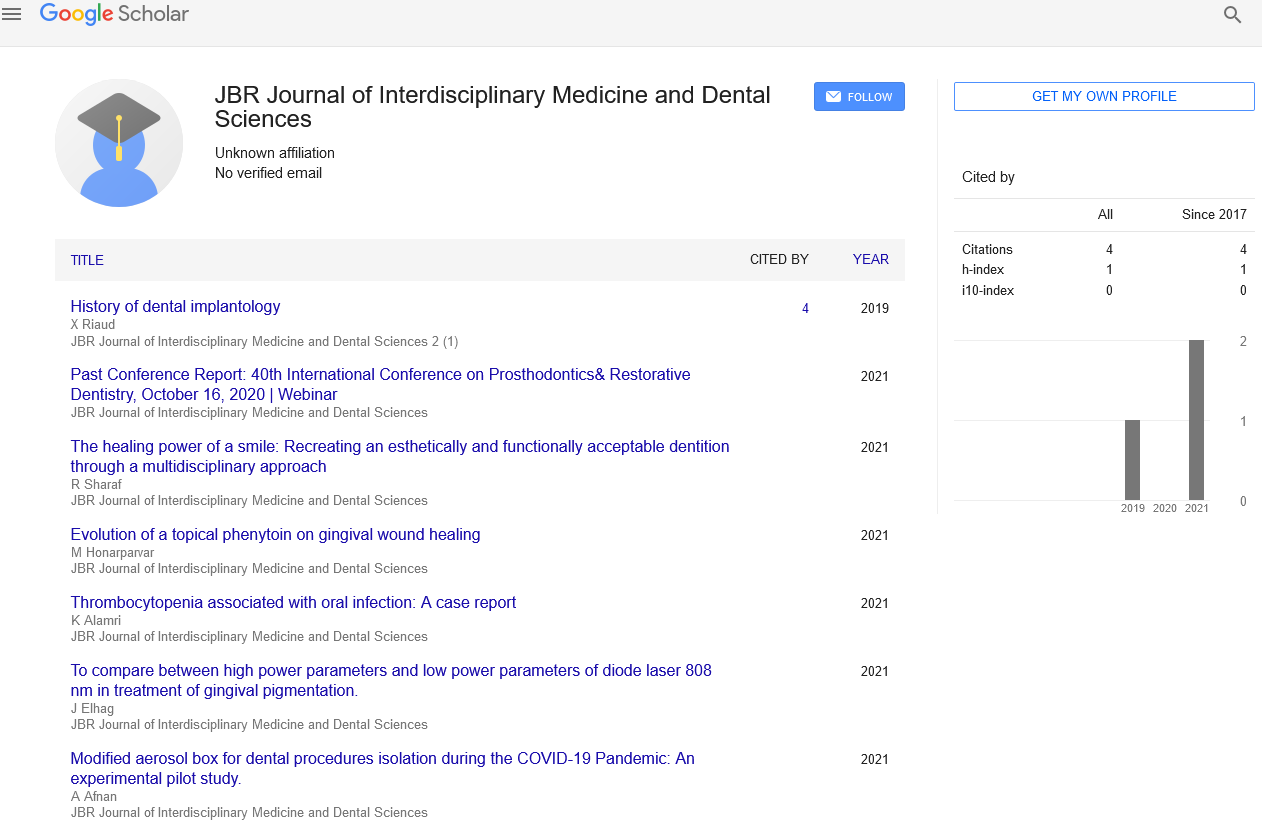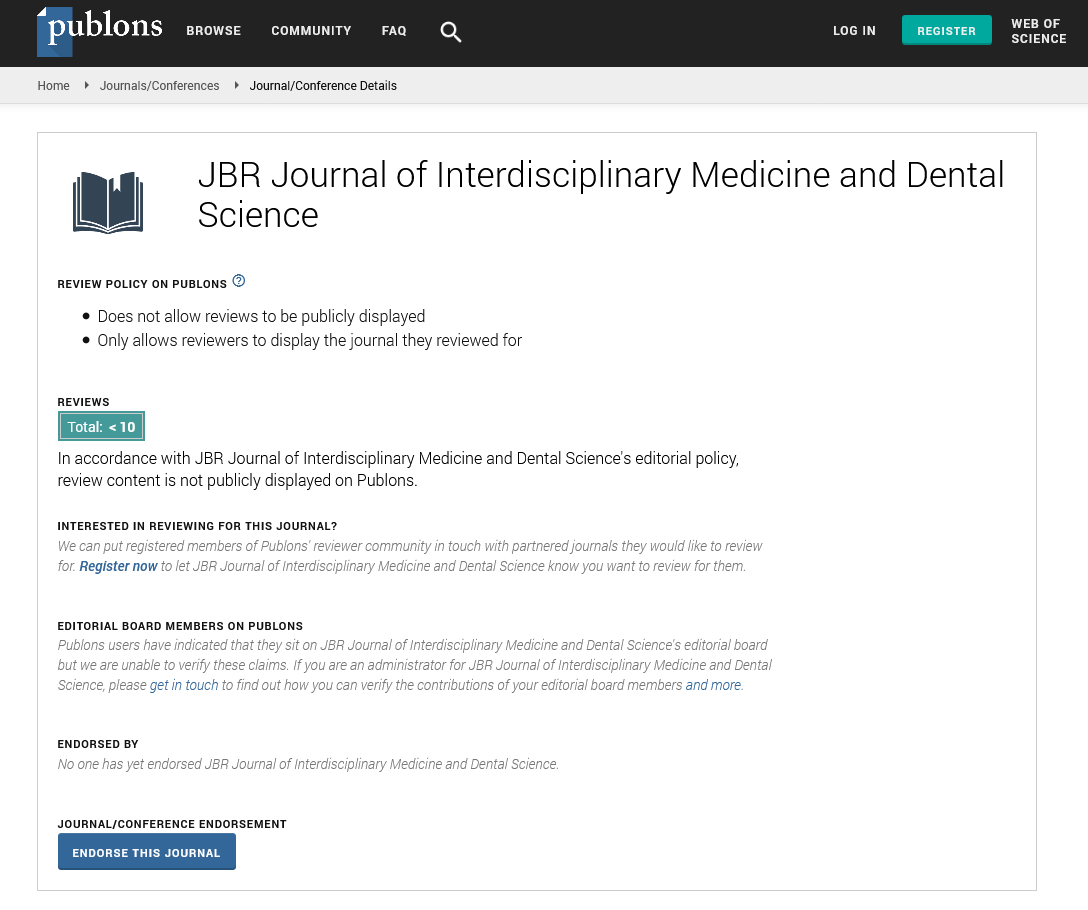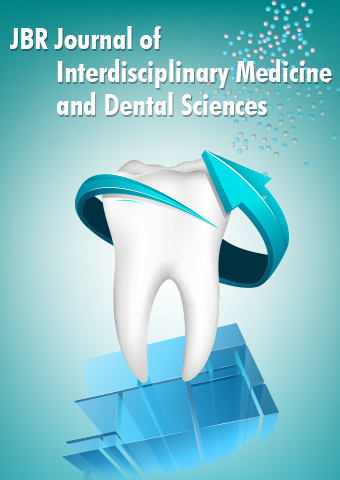Review Article - JBR Journal of Interdisciplinary Medicine and Dental Sciences (2023) Volume 6, Issue 2
A Review on the Periodontal Disease
Kamyar Yazdanian*
Department of Dental diseases, Baqiyatallah University of Medical Sciences, Iran
Department of Dental diseases, Baqiyatallah University of Medical Sciences, Iran
E-mail: kamyaz@edu.in
Received: 02-Mar-2023, Manuscript No. JIMDS-23-93512; Editor assigned: 04-Mar-2023, PreQC No. JIMDS-23-93512(PQ); Reviewed: 18-Mar-2023, QC No. JIMDS-23-93512; Revised: 23-Mar-2023, Manuscript No. JIMDS-23-93512(R); Published: 30-Mar-2023, DOI: 10.37532/2376- 032X.2023.6(2).23-25
Abstract
Periodontitis would be caused by the biofilm of oral pathogenic microorganisms caused by their coaggregation and multiplicity. Extracellular polymeric substances (EPS) enclose the individual bacteria in biofilms as a protective shield, shielding them from attack. It is essential and difficult to disrupt the EPS of pathogenic bacteria in order to treat periodontal disease. We hypothesized that these polymers might be capable of relieving periodontitis because our designed cationic dextrans had sufficient capacity for disorganizing EPS. We confirmed that cationic dextrans could effectively destroy biofilm in vitro by triggering the phase transition of EPS in biofilms, particularly those created by the keystone periodontal pathogen Porphyromonas gingivalis (P. gingivalis). In a rat periodontal disease model, satisfactory in vivo treatment was achieved. In conclusion, the study made use of the powerful biofilm-controlling capability of cationic dextrans to implement a practical and efficient treatment plan for periodontitis.
Keywords
Cationic dextran ▪ Phase transition ▪ Biofilm ▪ Dental plaque
Introduction
Periodontal illness is firmly connected with dental plaque biofilms on the tooth surface. Traditional antibacterial reagents are shielded from oral pathogens by the biofilm, which forms gel structures and covers the bacteria below. The effectiveness of these reagents in eliminating biofilms is limited due to their limited penetration into gel. In order to disperse encapsulated bacteria, our cationic dextran could eliminate the coverage of gel-like EPS. Because of their superior capabilities, they were able to successfully disrupt biofilm. Notably, by controlling dental plaque, cationic dextrans significantly reduced alveolar bone loss and periodontal inflammation in a rat model of periodontitis [1-3]. The scientific and clinical use of cationic dextrans should be expanded in light of the growing global concern about periodontal disease.
There are between 600 and 700 different kinds of bacteria in the human oral cavity. Oral wellbeing is exceptionally subject to the microbes balance. Dental plaque, the natural biofilm on teeth, has the potential to establish a harmonious relationship with the tissues that are adjacent to it in the physiological state. Biofilms are an intricate ecosystem in which bacteria are surrounded by self-produced extracellular polymeric substances (EPS) to protect them. A pellicle on the surface of the tooth is the first step in a multistage process that leads to the formation of dental plaque [4]. Glycoproteins from saliva comprise the majority of this pellicle. This covers the surface of the teeth, making it possible for oral bacteria to adhere and form plaque biofilms. However, when pathogenic bacteria, like the keystone bacteria P. gingivalis, excessively proliferate and accumulate, it will result in oral microbial dysbiosis and transform this “healthy” dental plaque into a “pathogenic” biofilm for periodontal diseases, which affect up to 90% of the global population of all ages. Inflammation of the supporting structures of the teeth (such as the gingiva, bone, and periodontal ligaments) is caused by the complex, multilayered pathogenic dental plaque biofilms, which then result in tooth loss. Periodontitis could be considered the primary cause of these redundant “pathogenic” biofilms, which must be eliminated promptly.
The elimination of pathogenic plaque biofilms is essential for infection prevention and treatment because periodontal disease is a significant medical challenge. Mechanical cleaning with brushing and flossing in personal care or professional scaling is currently the most cost-effective, safe, and effective method for controlling oral biofilm. In addition, some agents with antibacterial activity, such as antibiotics or antimicrobial materials, are used as an additional treatment to stop bacteria from growing too much. Unfortunately, these conventional antibacterial reagents only provide a limited improvement, and some of them come with undesirable side effects like diarrhea, vomiting, and tooth stains. Additionally, the recurrence of overgrown dental plaque and the development of antimicrobial resistance by oral pathogens will be induced by high antibiotic concentrations [5-7]. The effective diffusion barrier provided by the EPS in biofilms is a major contributor to the difficulty of biofilm removal. Because EPS restricts antimicrobial agents’ ability to penetrate biofilms, it is challenging for them to eradicate bacterial cells. As a result, the disruption of the EPS may be primarily responsible for the biofilms’ dispersion. Degradation enzymes for EPS components, such as protease, glycosidase, DNAase, and others, and have been used in a variety of strategies to disrupt EPS. However, it has been demonstrated that enzymatic degradation strategies are ineffective, and none of these potential therapeutic approaches are currently being utilized in clinical settings.
We first removed the biofilms of dental plaque from the surface of the teeth with cotton swabs in order to quantify the number of bacteria present. The swabs were then absorbed 1.0 mL of PBS, trailed by ultrasonic swaying to get a bacterial suspension [8]. On NB agar plates, the bacteria suspension was then diluted and plated. The CFUs were counted after 48 hours of incubation at 37 degrees Celsius. The viability of planktonic S. aureus, E. coli, and P. gingivalis bacteria was assessed using live-dead staining. In a nutshell, the bacteria were cultured in the medium until they reached late log-phase (OD600 nm approximately 1.0). The bacterial cultures were then centrifuged for five minutes at 4000 rpm, the supernatant was removed, and the pellet was suspended three times in the wash buffer (0.85% NaCl). Then, the got microbe’s cells were treated with cationic dextrans at various fixations or 0.85% NaCl (as a control) for 16 h. Thusly, the examples of planktonic microorganisms was stained with a LIVE/DEAD BacLight Bacterial Practicality Pack (L7012, Thermo Fisher Logical, and USA) as per the maker’s guidelines. Then, the stained examples were inspected, and pictures were caught by ZEISS LSM980 confocal microscopy. Live bacteria with intact cell membranes were shown as green when incubated with the SYTO 9 stain and the propidium iodide nucleic acid stain provided in the kit, while dead bacteria with compromised cell membranes were shown as red.
Discussion
By using the cationic dextran to cause EPS disorganization in the biofilm, our study demonstrated that they are effective periodontal treatment agents. As of now, the really clinical restorative techniques are brutal mechanical expulsions, for example, water showers and planes, or ultrasound. However, these methods had poor results, and in order to guarantee their biosafety, they are only used in clinical settings at lower intensities to fluidize biofilms rather than completely removing them, which reduces their effectiveness. In contrast, the biofilm disruption advantages of our designed cationic polymers were superior. By inducing phase separation within a short period of time (two hours), they were able to sufficiently disrupt the EPS matrix’s structural integrity to provide a habitat for the EPS matrix’s bacteria. Electrostatic interactions induced by cationic dextrans and the subsequent phase transition of EPS may be the cause of the damaging effects in the treated biofilm. There are many different components in the EPS of bacteria biofilm. The structural and functional components of the matrix are found in EPS, with the exception of the water (up to 97 percent). Amyloid, cellulose, fimbriae, pili, and flagella, as well as soluble, gel-forming polysaccharides, proteins, and extracellular DNA. The fact that the typical macromolecular composition of a particular biofilm always consists of one cationic molecule (Pel in biofilms of Pseudomonas aeruginosa, curli in biofilms of E. coli, and Salmonella Typhimurium) and several anionic polymers (polysaccharides, DNA, or proteins) is interesting among these components. Therefore, the architecture’s linchpin ought to be a single cationic macromolecule among numerous negatively charged components. As previously mentioned, our designed C-Dex and DETA-Dex, as an additional additive cationic component, would cause the EPS architecture to collapse by interfering with the fundamental interactions that hold the biofilm’s gel-like structure together [9]. Importantly, despite the fact that C-Dex and DETA-Dex could kill bacteria dispersed from biofilms in vitro after 16 hours of treatment, they were unable to kill bacteria in 2 hours. This indicates that the bactericidal properties of cationic dextran in the biofilm are time-dependent, which could ensure its biosafety and prevent adverse effects when administered in vivo.
Conclusion
Due to their superior capacity for disorganizing EPS in biofilm, we used effective biomaterials in this study to treat periodontitis. The signs of cationic dextrans went from Gram-positive and Gram-negative microbes, particularly the P. gingivalis, and a cornerstone periodontal anaerobic microorganism. In order to disperse encapsulated bacteria, our cationic dextran could eliminate the coverage of gel-like EPS. Because of their superior capabilities, they were able to effectively control biofilm [10-14]. Notably, by controlling dental plaque, cationic dextrans significantly reduced alveolar bone loss and periodontal inflammation in a rat model of periodontitis. We discovered that cationic dextrans may become promising generic clinical reagents for biofilm-induced disease thanks to their successful periodontal treatment. It merits extending its application in safeguarding from bacterial biofilms in oral inserts and other implantable clinical gadgets.
Declaration of Competing Interest
The authors declare that they have no known competing financial interests.
Acknowledgement
None
References
- Butt AM, Ahmed B, Parveen N et al. Oral health related quality of life in complete dentures. Pak Oral Dent J. 29, 397–402 (2009).
- Agarwal V, Khatri M, Singh G et al. Prevalence of periodontal Diseases in India. J Oral Health Community Dent. 4, 7–16 (2010).
- Indian Dental Association. National oral health program. Bombay Mutual Terrace. 1,7 (2009).
- Pandve HT. Recent advances in oral health care in India? Indian J Dent Res. 20,129–130 (2009).
- Dudala SN, Arlappa N. An updated Prasad's socio economic status classification for 2013. Int J Res Dev Health. 1, 26–28 (2013).
- Sharda A, Sharda S. Factors influencing choice of oral hygiene products used among the population of Udaipur, India. Int J Dent Clinics. 2, 7–12 (2010).
- Bhat PK, Kumar A, Aruna CN. Preventive oral health knowledge, practice and behaviour of patients attending dental institution in Bangalore, India. J Int Oral Health 2, 17–26 (2010).
- Dasgupta U, Mallik S, Naskar S et al. Dental problems and its epidemiological factors- a study on adolescent and adult patients attending dental OPD of a tertiary care hospital in Kolkata, India. J Dent Med Sci. 5, 1–7 (2013).
- Barrieshi-Nusair K, Alomari Q, Said K. Dental health attitudes and behaviour among dental students in Jordan. Community Dent Health. 23,147–151 (2006).
- Vadiakas G, Oulis CJ, Tsinidou K et al. Socio-behavioural factors influencing oral health of 12 and 15 year old Greek adolescents. A national pathfinder survey. Eur Arch Paediatr Dent. 12, 139-145 (2011).
- Kwan SY, Petersen PE, Pine CM et al. Health-promoting schools: an opportunity for oral health promotion. Bull World Health Organ. 83, 677-685 (2005).
- Sharma N, He T, Barker ML et al. Plaque Control Evaluation of a Stabilized Stannous Fluoride Dentifrice Compared to a Triclosan Dentifrice in a Six-Week Trial. J Clin Dent. 24, 31-36 (2013).
- Dwivedi S, Mittal M, Vashisth P et al. Oral Hygiene Pattern observed in Primary School Children as Reported by Their Mother: A Longitudinal Study. World J Dent. 3, 308-312 (2012).
- Shenoy RP, Sequeira PS. Effectiveness of a school dental education program in improving oral health knowledge and oral hygiene practices and status of 12- to 13-year-old school children. Indian J Dent Res. 21, 253-259 (2010).
Google Scholar, Crossref, Indexed at


